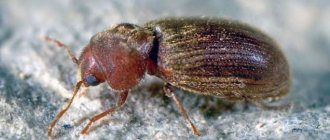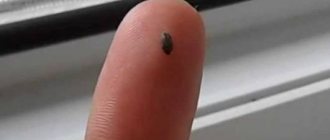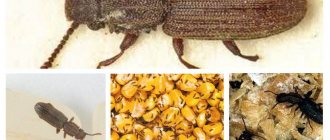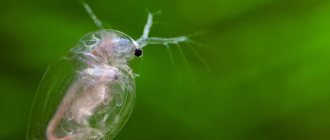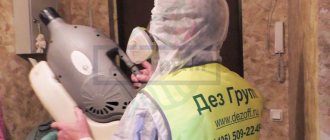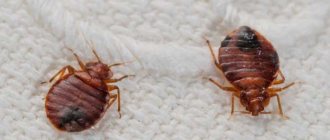Bedbugs are harmful blood suckers
Bed bugs belong to the group of blood suckers and can cause significant harm to humans. The insect is easy to recognize by its characteristic features:
- body length ranges from 4 to 8 mm;
- shell color – light yellow or dark brown;
- active after dark;
- the only food product is blood.
Parasites live on average up to one year. You can easily find them in old pillows, mattresses, as well as between floorboards, under linoleum, wallpaper or baseboards. Bedbugs leave bites on the human body. In general, they are not dangerous, but can cause allergic reactions.
Who bites at night?
Living next to insects that harm food or just frighten you with their appearance is not so bad, but experiencing a negative impact on yourself is a real disaster. Particularly unpleasant is restless sleep, during which an incomprehensible itching occurs every now and then, accompanied by the appearance of red spots on the body in the morning.
It is perhaps very difficult to immediately guess what the true cause is, and the unfortunate person is ready to attribute the detected rash to allergies, irritation or mosquito bites. But if you take a closer look at your sheet, you may find a rather unpleasant surprise: black dots, as well as droplets of blood. This is where everything becomes clear - these are bedbugs.
Bedbugs are predominantly nocturnal, and when light appears they hide, so people often don’t understand where the redness on their hands and feet came from. But, if you carefully examine the mattress, try to lift it, look into the folds of the bed linen, you can find the culprit itself. To make sure that it really is a bug, you need to know a little about the features of its appearance.
The length of an adult does not exceed 8 mm, the color of the body, as well as its shape, vary depending on the satiety of the insect. So, if a hungry bug looks like a flat red coin, then a satiated parasite becomes rounded and changes its color to brown or almost black. The larvae are very similar to adult insects, the only difference being the size and translucent body color. The eggs are similar to a grain of rice. It is worth noting that the female is capable of laying about 4-5 eggs per day at a time and about 300 throughout her life.
Therefore, there is absolutely no point in delaying taking measures to destroy these parasites, especially considering the fact that bedbugs can cause not only an allergic reaction, but also give you hepatitis B. It has now been established that these insects are only carriers of many infectious diseases that It is impossible to get infected from them, but it is hepatitis B that can enter the human body through bedbug excrement if you accidentally touch it.
Calling a special disinfection service to your home, as well as taking certain preventive measures, will allow you to forget about the problem as soon as possible.
Domestic bloodsuckers - mosquitoes
Having a clear understanding of what kind of domestic insects exist in the apartment (the photos and names below will simplify the task of recognition), you can quickly find your bearings when meeting with representatives of different groups to develop a plan to combat and prevent their appearance.
The mosquito, for example, also belongs to the group of blood-sucking mosquitoes and is found in almost everyone’s home with the onset of warm days. The insect has a body length of up to 7 mm, most often distinguished by a yellow color.
Female mosquitoes drink human blood and also do not disdain plant juice; males feed exclusively on plant juice.
The average female mosquito lives on average from 43 to 57 days. Life expectancy is affected by temperature and humidity, but most of all by the availability of power sources. The male lives no more than 19 days.
Considering that female mosquitoes feed on human blood, they can be considered pests. Insects can cause infection with malaria, meningitis, yellow fever and other diseases.
Fleas are small blood-sucking pests: features
Just like mosquitoes and bedbugs, fleas belong to the blood-sucking group. Unpleasant-looking small insects leave their shelters at nightfall and lead a parasitic lifestyle. The body length of the pest does not exceed 5 mm (the largest individuals), the color is dark. The source of food for fleas is blood, both human and animal.
The average lifespan of an adult is several months. The main problem is that insects actively reproduce, laying larvae in secluded places:
- behind the baseboard;
- behind the wallpaper;
- under carpets;
- in soft toys, etc.
Similar to mosquitoes, fleas can become carriers of dangerous infections such as plague, encephalitis, hepatitis and others.
Domestic insects in the apartment: photos and names
By building his home, a person fences himself and his loved ones off from extraneous creatures, but one way or another, some of them still penetrate the house, causing harm to the health of the owners or simply annoying with their unattractive appearance. Of course, we are talking about insects, of which a lot are currently known. However, life in high-rise buildings or in an ordinary residential building does not appeal to everyone. But those who still strive to take over part of a person’s living space can be divided into several groups.
Depending on the degree of harm and danger to people, the following categories are distinguished:
- Parasites that live off human blood: bedbugs, lice, fleas, mosquitoes. Blood-sucking insects spread very quickly and pose a direct threat to human health, as their bites cause itching, irritation, redness, an allergic reaction and even nervous breakdown. In addition, some of these species are capable of infecting their prey with dangerous infections, such as hepatitis B, salmonellosis, tularemia, sarcopsillosis, and pulicosis.
Therefore, you should get rid of such insects and the sooner the better. - Pests that cause damage to food or household items: cockroaches, moths, ants, red flour beetles, flour beetles, flies, grinder beetles, book lice, carpet mites, ground beetles, woodlice.
- Harmless insects: spiders, silverfish, flycatchers.
- Insects that accidentally entered the house: mosquitoes, midges, flies, beetles, moths, wasps, bees.
If there are no sources of excess moisture in the house, food that is in the public domain is controlled, waste is regularly thrown away, and wet cleaning is carried out using cleaning products, it is likely that there will be no need to fight some insects at all.
Cockroaches are the most frequent “guests” in the house
Analyzing which insects at home can disturb peace and comfort, it is difficult to forget about cockroaches. Everyone has encountered their neighborhood at least once in their life. Insects belong to the category of harmful domestic insects, which, like the previous representatives of this group, lead an active nocturnal lifestyle. The body size of the cockroach does not exceed 9.5 cm. The color is predominantly yellow-brown or dark.
Pests choose all kinds of food scraps as a source of food and do not disdain feces. An adult lives for about 30 weeks in secluded places, out of sight of humans. Most often these are holes between the floor and the baseboard, cabinets and chests, old suitcases, etc.
Pests cause damage to indoor plants, furniture, food, are capable of spreading dangerous infections and cause the development of helminths.
House ants – what harm do they do?
Another unpleasant and harmful household insect is the ant. Belongs to the Hymenoptera family. Leads a predominantly active both day and night lifestyle in close proximity to humans. On average, an adult ant has a body from 2 to mm in length, eats everything without exception, especially loves sweets, fish and meat products.
The house ant is easy to detect - it does not hide and has a bright yellow or brown color. Insects live in large families; their number in an apartment or house can reach several thousand.
The average lifespan is about two months for females, while the female queen lives up to 275 days. The habitats of insects are as close as possible to their food source. Ants cause damage not only to food, but also to plants, and are also considered carriers of diseases.
Where do skin beetles come from in an apartment?
Adult insects have wings. Consequently, they are able to travel through the air over considerable distances and penetrate through windows without mosquito nets and open balcony doors of apartments.
In addition, they can:
- Enter from neighbors through the ventilation system.
- When insects are small, up to 1 cm in size, they can be easily brought home from the street on clothes and shoes without noticing it.
- They often get into apartments on the fur of pets.
- They can be purchased together with used items, especially antiques, clothes made of genuine leather, and books from ancient editions.
That is, this means that they can appear and settle in any premises. Uninvited guests that are not detected in time will begin to actively reproduce, and then you will have to fight their voracious larvae, because from a large number of them the material damage can be colossal. Actually, it is the larvae of these beetles that are merciless pests.
What a skin beetle looks like - photo
Without knowing exactly what carpet beetles and their offspring look like, it will be difficult to notice and identify them. Although they are active mainly during the day, their dull color allows the insects to camouflage well. And the habit of hiding in cracks makes them invisible.
Photo: https://otvet.imgsmail.ru/download/u_5e964b5be0d293bcb3e733f57a76152f_800.jpg
Meanwhile, the distinctive features of these pests will be:
- Body length from 3 to 10 mm.
- Oval body shape with a convex top and a flatter bottom.
- The color is predominantly brown, sometimes with a reddish tint. Against this background, a pattern of excellent color in the form of strokes or spots stands out.
- Hard elytra.
- A small head with club-shaped antennae that can fold and hide in the grooves on the cheeks.
- In many species, the entire body is shaggy, covered with hairs, which at the end form a tuft or fan like a tail.
Favorite habitats in apartments
The habit of skin beetles gathering together makes them easier to detect, and as a result, it becomes easier to remove them from the house. Most often they cluster near heating radiators, in cracks under baseboards. Large colonies are found near closets, where they hunt for clothes, and near beds, where they are attracted to bedding fabrics and pillows. There are a lot of them on and under carpets - this is also the favorite food of bugs.
In all these places, insects not only feed, but also reproduce. Each female lays up to hundreds of eggs. After a month, small larvae appear from them, which, as they grow, become most harmful at the age of 55 days. During this period they are very mobile. They look like worms dressed in a hard, shiny brown oval-shaped shell covered with thick hairs.
What do leather beetles eat?
At the posterior end, tufts of long villi form a kind of tail. If the apartment is warm and there is enough food, the larvae grow quickly and go through 5-7 molts before turning into adult skin beetles. And they eat a lot and everything. And they always find something to live in the apartment, starting to destroy unique collections and rarities as readily as woolen sweaters and leather shoes.
That is, they can eat:
- Meat products.
- Smoked and dried fish.
- Powdered milk and cheese.
- Cereals, grains, pasta.
- Apply dry glue to the back of the wallpaper.
- Feathers from pillows.
- Woolen clothes.
- Fur coats and carpets.
- Book bindings.
- Stuffed animals.
- Herbariums and dead insects from entomological collections.
- Furniture.
- Fabrics made from natural silk, linen and cotton.
- Clothes and shoes made of genuine leather and suede.
Can the leather beetle bite a person? If you pick it up, it may bite. The bites of these insects are very painful, often lead to allergic responses and can become a source of infection with dangerous microbes. In addition, they can be intermediate hosts of helminths dangerous to humans, which are contracted from rodents.
Moths - why are they dangerous not only for clothes?
When analyzing what other insects may live in your apartment, it is worth stopping at moths. The domestic pest causes significant damage not only to fur and wool items, but also to food products - mainly cereals. Clothes moths like to feast on clothes, and food moths like to feast on human food.
It is not difficult to recognize an adult moth - it is a miniature dark-colored butterfly. It should be remembered that the danger is not the butterfly in adulthood, but the caterpillars before the pupation period. It is the caterpillars that leave traces of their presence on food and clothing.
Woodlice - how do they appear and how are they different?
Unpleasant woodlice, which make themselves felt in a house or apartment from time to time, are difficult to classify as permanent household insects. This is an example of an arthropod from the class of higher crayfish. However, woodlice can be found at home quite often.
Remembering what types of domestic insects pose a danger to humans, it is worth noting that woodlice are almost completely harmless. These arthropods are not capable of causing damage to human health and all they can do is spoil young plants in the house or stocks of vegetables.
Insects appear in rooms with high humidity levels. Most often this is the kitchen, bathroom, toilet. Here they hide from bright light, just like most domestic insects. Woodlice choose food scraps as a source of food.
Fighting woodlice is very simple - just work to create conditions that are unacceptable for them with low humidity levels and a lack of food sources. Insecticides Delta-Zone, FOS, Tsifoks and others are suitable as auxiliary preparations.
House beetles
Even in a clean apartment there are uninvited six- and eight-legged guests, and what can we say about microscopic neighbors that can be on the skin of people and animals. They usually enter the house through windows, window sills, any cracks, drainpipes, and ventilation holes. No human habitation could do without their presence.
In the kitchen you can most often find:
- Cockroaches;
- Weevils;
- Muravyov;
- Senoyedov;
- Fruit flies;
- Flour beetles.
Cockroaches are the fastest and hardiest creatures that have lived on earth for 4 million years and number 4,000 species. They move at a speed of about 400 km/h, can not breathe for about an hour and can go without food for 1 month.
Weevils. They pierce any packaging with their proboscis. These insects breathe using microscopic holes in the skin. Hiding from direct sunlight in boxes with cereals, they lay up to 400-500 eggs.
Ants often enter apartments along with fruits and vegetables from the home garden. They feed on leftover human food. The bites of some ant species are very painful to humans. Therefore, it is better to get rid of them quickly. This is fairly easy to do by spraying the area with insect repellent spray.
Hay eaters appear in any room with constantly high humidity. These are small, fragile white insects with transparent wings. They feed on organic food, but can go without food for a long time. Mold is a favorite delicacy that attracts hay eaters to the apartment. You can get rid of their presence by eliminating pockets of constant dampness.
Fruit flies. Their larvae develop in plant debris: fruits, vegetables, etc. They are also called fruit flies. Like flies, they are carriers of infection. Whole swarms of flies may appear over rotten fruit. You should get rid of them by throwing out garbage on time and following the rules for storing and processing fruits and vegetables.
Flour beetles. An adult beetle reaches 12−19 mm in length. Its body is flat, light brown, and reddish below. Their larvae are 2 mm in size, yellow in color and have no eyes. They eat cereals and flour. In addition to grain and flour, the beetle can be found in starch, dried fruits, seeds, and also feed on fabric and wool.
The bedroom is most often inhabited by:
- Dust mites;
- lice;
- Bedbugs;
- Carpet beetles.
Ticks are creatures that feed on dead skin particles. Therefore, bed linen, mattresses, sofas and pillows are like a 24-hour dining room for them. On average, there can be about 10 billion individuals in each person's bed. Dust mites cause allergic reactions in people with asthma. The dust that forms from the remains of their vital activity irritates the respiratory tract and lungs. In 1 sq. m of carpet, there are about 100,000 of them. Ticks do not survive at temperatures below zero.
Kozheed. His body contains enzymes that can process keratin. The larvae of the leather beetle eat wool, thereby spoiling woolen items. But at the same time, they can be useful because they eat dead insects and fallen hair.
Blood-sucking parasites
Lice . Contrary to popular belief, lice grow in clean hair. Clean hair is easier to move through, as it slips less due to the lack of oil on it. Long hair is more likely to harbor lice than short hair, because it is easier to attach to it. They cling to hairs using six legs with claws. On average, no more than 5-10 individuals live on an infected head.
There are still cocoons of lice in the hair. The louse, being on the head for about a month, lays many eggs. If you do not remove lice in time, everyone around you can become infected. Insects drink blood at least once a day. Lice saliva prevents blood clotting. Initially, the body of a young individual is colorless, but its color changes after the first meal.
Body lice hide in the folds of dirty clothes. Their lifespan is twice that of a head louse. They are more fertile. Dangerous diseases can be transmitted through their dried excrement. For example, a body louse can become a carrier of typhus and other diseases.
Fleas .
Thanks to its flat, armored body, the flea easily penetrates animal fur. With its large jaws it pierces the skin and blood vessels. Two pumps in her head help her suck out blood. Fleas move with the help of several pairs of legs and can jump up to 20 cm. These parasites are carriers of many diseases, the most dangerous of which is the plague. Bedbugs are parasites of warm-blooded animals and people; they feed on their blood. It is believed that they originally existed in caves. Bedbugs feed on blood at all stages of development. Most people do not notice bedbug bites. You can detect bedbugs in bed only by numerous brown spots. If a room is heavily infested with bedbugs, a specific smell may appear.
Mosquitoes are blood-sucking insects. Moreover, only females feed on blood. Their upper and lower lips are elongated and form a kind of pencil case, which contains sharp and thin needles. Unlike females, males have poorly developed these organs and they do not bite, but feed only on plant sap. Mosquito larvae and pupae live in stagnant bodies of water. In cities, they fill warm and humid rooms, such as the basements of residential buildings.
They are parasites and can carry infection. As a result of the bite, a person experiences severe itching and may develop eczema and hives. You won't be able to get rid of them completely, you can only control their number.
Harmless bugs
The following insects can be found in the bathroom at home:
- Silverfish;
- Woodlice;
- Pintails;
- Flycatchers;
- Spiders;
- Centipedes.
The woodlouse is a garbage-collecting insect. Its body, covered with “armor,” reaches a length of no more than 20 mm. They eat rot, mold, excrement and members of their own species. Six times a year they shed their shell, becoming completely defenseless. To absorb oxygen, their gills, which are located on the abdomen, must remain moist.
These insects are able to absorb water from both ends : the mouth and tubes near the rectum. Due to the high calcium content in their shells, there was a time when these insects were sold in pharmacies as a cure for indigestion. This is how they got the name “pill bugs.”
Silverfish. Little bugs that eat literally everything thanks to their body’s ability to produce cellulase, a breaking down enzyme. These microscopic black bugs can be seen on book spreads. They are also called bookworms.
Pintails. Another name for this insect is earwig or mite. Also the most common name is pincher. This is an omnivorous insect. In apartment buildings, they are most likely attracted by the presence of a variety of food and other insects, which they also feed on (or rather, their remains). Pintails reach 12-17 mm in length. Long antennae extend from the head. They can fly, but are reluctant to use their wings.
They deserve special dislike because they bite painfully or pinch with their tongs, biting through the skin until it bleeds. But they do this solely for the purpose of self-defense. In addition, they are very useful because they eat aphids.
Flycatchers. They start in different rooms and look like furry caterpillars. They move quickly and feed on other insects: flies, mosquitoes, midges, and silverfish. They may bite in self-defense.
Spiders weave their silk webs using special glands. The thread they throw out hardens when exposed to air. They calmly move along their web, waiting for their prey. If the victim is caught, then she will never get out. The web in the corners looks unaesthetic, but still the benefits of the spiders themselves are undeniable. They kill harmful insects. Many spiders catch and eat insects twice their own weight in a day.
Centipedes. The length of centipedes ranges from 2 mm to 30 mm. Millipedes belong to the superclass of invertebrates, although some people mistakenly consider them insects. Kivsyaki is one of the types of centipedes common in Russia. They look very impressive because they look like a long black smooth caterpillar with many legs.
Carpet beetles: what harm do they cause?
In houses and apartments, not only mosquitoes, bedbugs and cockroaches, but also some types of beetles can be annoying. So, for example, bugs in an apartment (photos and names will help you better navigate among the variety presented) called skin beetles live in close proximity to a person so that the latter most often does not suspect about him.
The reason is simple - adult individuals are so small that they are almost impossible to notice. The easiest way to find insects is in places where paper, clothing or skin accumulate, which are a source of food for them.
Fighting beetles is not difficult. Aerosol insecticidal preparations, as well as some types of folk remedies - lavender and wormwood, for example, the smell of which is intolerable to insects, both adults and larvae, have an excellent effect.
What insects are found in the bathroom?
The bathroom must be kept especially clean, because this is the room where a person maintains the hygiene of his body.
But sometimes the kingdom of sanitation created by the owner is disrupted by the appearance of various insects, which can be:
- silverfish;
- woodlice;
- centipedes;
- flycatchers;
- spiders;
- cockroaches.
Perhaps it is worth figuring out which of these insects are harmless and which pose a potential threat to the health of residents.
Silverfish and woodlice
Most often, these insects are found in single form. It is very easy to recognize them: they have an elongated body with three antennae at the end and two at the front. The color of silverfish is usually light gray, or white if the insect has recently molted. They do not pose any danger to humans, but with their far from attractive appearance they pretty much spoil the mood.
In addition to mood, silverfish can also ruin toilet paper or rags for cleaning an apartment if they have been left undried for a long time. Perhaps there are constant sources of moisture in the bathroom, which attracts silverfish. You can get rid of them by eliminating various types of leaks that cause moisture and drying the room.
It is for these reasons that wood lice, which are essentially not insects, but related to crustaceans, can appear in the bathroom. It is quite simple to distinguish them from silverfish: woodlice are characterized by a chitinous cover that resembles armor, and when danger arises, they curl up into a ball, imitating their death. The body size does not exceed 1 centimeter, the color is usually gray. It should be noted that wood lice are not capable of carrying any infections, however, this does not mean that there is no need to fight them, because crustaceans can spread to such a scale that you will not want to go into the bathroom at all.
Flycatcher and spider
A flycatcher, which is characterized by a disgusting appearance, can inspire genuine horror in the owner of an apartment. This is a fairly large insect, reaching a length of up to 6 centimeters. The yellowish-gray and flattened body has 15 segments, each of which contains a pair of long legs. The flycatcher also has very long antennae. Thanks to such features, the insect is difficult to confuse with any other.
The flytrap starts in completely different rooms, including the bathroom. The main reason for the appearance of this insect is the presence of other pests in the house, which it feeds on. These could be mosquitoes, midges or silverfish. The owner of the house should not be afraid of infections, since flycatchers cannot tolerate them, but they are quite capable of biting for the purpose of self-defense, and the degree of pain of the bite can be compared to a bee sting.
Spiders are also harmless to human health; they are usually not found in large numbers; as a rule, there are 3-5 individuals. The only harm they cause is cobwebs in the corners of the room, which significantly spoil the appearance of the room.
Cockroaches
But cockroaches, which were discussed above, are a direct source of pathogenic bacteria entering the house, which entail many undesirable consequences. Therefore, it is these insects that need to be gotten rid of as soon as they are noticed.
Centipedes
Today, more than 13 thousand species of centipedes are known. The name of these insects speaks for itself: the pest has many legs, and if one species has 30 of them, then another may have several hundred. Another distinctive feature is the presence of a long body. The favorite habitats of centipedes are damp rooms that are not cleaned regularly (bathrooms, warm and damp basements, and attics). Having encountered this very unsightly creature at home, a person wonders what harm it can cause to household items.
Yes, none. Centipedes are not at all interested in books, damp paper, clothing or food, but other insects that annoy the owner with their presence will serve them as excellent food. Therefore, to some extent, centipedes can be confidently called useful home cleaners. However, there is one fact that can ruin this idyll: a centipede can bite in self-defense, and its bite is quite painful; as a rule, the pain is felt for about 1-2 days. In addition, there is such a species of these insects as scolopendra, which is considered poisonous.
It is not capable of causing serious harm, but burns and irritation may well occur. In some cases, there is a slight increase in body temperature, severe weakness and numbness of the affected area of the skin. In this situation, analgesics, as well as ice or, conversely, a heating pad, will help cope with these undesirable consequences.
Who are silverfish and why are they dangerous?
Infrequently, you can see silverfish in apartments - insects that are similar to woodlice. Just like their relatives, they live in places of high moisture, choose food waste as food sources, and cannot tolerate light.
The most common insects from this group living in apartments are sugar silverfish. They do not pose a threat to human health, but they cause some discomfort in the neighborhood, so they can be caught using ready-made or homemade traps.
Haymaker and flycatcher in the house - where are they most often found?
In a house or apartment you can find insects of various types, and the flycatcher is no exception. The insect is unpleasant to look at; a characteristic feature is a huge number of thin legs.
The flycatcher is not dangerous to humans; moreover, it brings certain benefits by catching and feeding on cockroaches, flies and bugs. They live in dark places, emerging into the light only in exceptional cases.
Another option for a “domestic” spider is the haymaker. For humans, the spider does not pose any harm; moreover, just like a flycatcher, it helps to cope with small insects, catching them for food. You can find a spider in the most secluded and dark corners of the apartment.
They fight the spider with conventional insecticidal agents, as well as with sticky tapes and traps.
Methods to combat silverfish
If you see these long insects in your own bathroom, take immediate action. There are several ways to remove silverfish. Let's look at each of them.
Method 1. Physical
To get rid of white bugs, create conditions for them that are unacceptable for life. Carry out a general cleaning in the bathroom - wash away the dirt and hard deposits that have appeared under the sink, toilet, bathtub and near the water supply. Add any product containing chlorine to the washing water. As soon as this layer dries, treat the surfaces with a solution of copper sulfate. After waiting a few hours, you can wash the floor again.
As for high humidity, you can reduce its level with special heaters or thorough ventilation (especially after taking a bath or shower).
Method 2. Insecticidal
To combat silverfish, chemical aerosols intended for baiting household parasites are also suitable. You will have to use them for at least a month, performing treatment once a week.
Advice! Carry out disinfestation not only in the bathroom, but also in the rest of the apartment, because these bugs can easily end up in the bedroom, living room or kitchen.
Some of the most popular and effective aerosols include the following:
- Raptor;Mosquitall;Combat;Antimol;Dichlorvos;Raid;Clean House;Armol;Extramit.
Important! When working with chemicals, be sure to use personal protective equipment - goggles, rubber gloves, mask or respirator.
When performing treatment, close the windows and doors, wait the time specified in the instructions, and then ventilate the room and carry out wet cleaning. Wash especially thoroughly those surfaces that come into contact with your hands.
Method 3. Lures and traps
If you are bothered by transparent bugs in the bathroom, use special traps against them. Ideal for these purposes:
- Wet birch brooms - just place them in the corners and leave them overnight. In the morning, they must be carefully taken out of the room and thrown into a trash bin or burned; Glass baits. Wrap the outer surface of the jar with tape or paper - the rough surface will allow the insect to easily get inside, but will not be able to get out. To be safe, place a piece of sweet fruit, a handful of sugar or a couple of berries on the bottom;
- Paper. Dampen a roll of paper napkins or toilet paper and leave it overnight. Silverfish love moisture, so they will definitely climb into this shelter. In the morning, you need to burn it or throw it away without unwrapping it.
Wet paper serves as food for silverfish, so this bait is quite effective and can quickly rid you of insects
Method 4. Folk remedies
Small white insects have been known for a long time, so humanity has managed to find several recipes that will quickly and safely solve this problem:
- In dark corners, under baseboards, between floor tiles and in cabinets, sprinkle diatomaceous earth, a special food powder that kills crawling parasites;
- Lay a path of ground zest - silverfish cannot tolerate its aroma. After 5 days, update the protection; Powder the room with spices - especially white bugs do not like the smell of cloves; Wash all surfaces with water with the addition of lavender or citrus essential oil; Sprinkle a mixture of boric acid (1 part) and chalk near the pipeline, as well as around the toilet and sink ( 4 parts). Leave them for a week and then update.
Advice! If silverfish have multiplied throughout the apartment and you cannot get rid of it, it is better to contact the SES.
